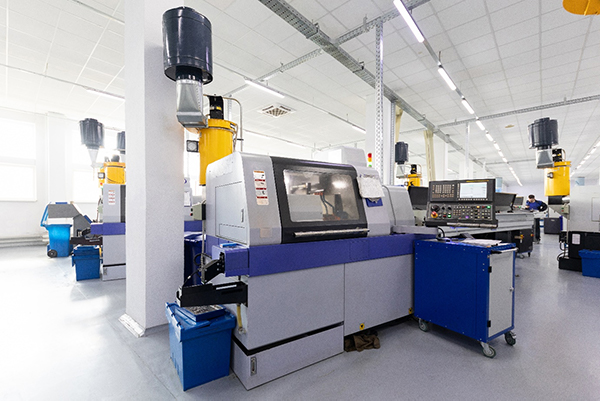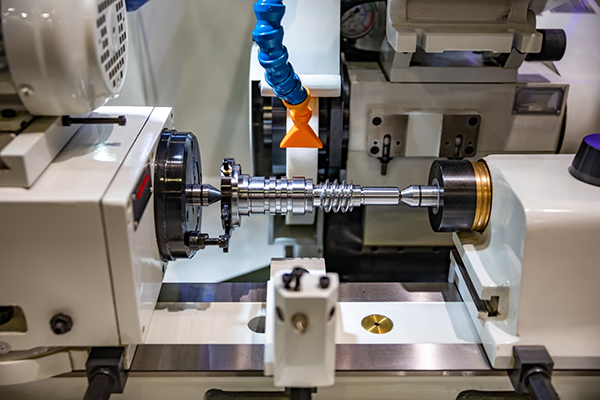बुर्ज: बुर्ज कई अलग-अलग काटने के उपकरण रखता है, जिससे मशीन प्रक्रिया के दौरान स्वचालित रूप से उपकरण स्विच कर सकती है। यह सीएनसी लेथ को बिना रुके कटिंग, ड्रिलिंग या ग्रूविंग जैसे कई ऑपरेशन करने में कुशल बनाता है।सीएनसी खराद पर संसाधित सामान्य सामग्री और हिस्से

कुछ स्थितियों में, सीएनसी लेथ कई प्रकार की धातुओं, जैसे स्टील, एल्यूमीनियम और पीतल सहित कई प्रकार की सामग्रियों के अलावा प्लास्टिक और यहां तक कि लकड़ी को भी संभाल सकता है। मशीन का लचीलापन इसे कई भागों को उत्पन्न करने की सुविधा देता है, जिनमें शामिल हैं:
पेंच: फास्टनरों के लिए बिल्कुल गोल और समान धागे।
बुशिंग्स: छल्ले जो यांत्रिक प्रणालियों में घर्षण को कम करते हैं।
• फिटिंग और कनेक्टर: प्लंबिंग, ऑटोमोटिव और एयरोस्पेस अनुप्रयोगों में उपयोग किया जाता है।
• इन भागों का उपयोग आमतौर पर उन उद्योगों में किया जाता है जहां सटीकता और दोहराव महत्वपूर्ण हैं, जैसे ऑटोमोटिव विनिर्माण, एयरोस्पेस इंजीनियरिंग और यहां तक कि चिकित्सा उपकरण उत्पादन भी।
• सीएनसी मशीनों और सीएनसी खराद के बीच मुख्य अंतर
• सीएनसी लेथ और सीएनसी मशीनें आधुनिक विनिर्माण के लिए अपरिहार्य उपकरण हैं, प्रत्येक अद्वितीय क्षमताएं प्रदान करती हैं। दोनों मशीनें कार्यों को स्वचालित करने के लिए कंप्यूटर कोड का उपयोग करती हैं, लेकिन जिस तरह से वे काम करती हैं, वे सामग्री को कैसे संभालती हैं, और उनके पास कौन सी अन्य विशेषताएं हैं, इस पर एक बड़ा प्रभाव पड़ सकता है कि एक परियोजना कैसे आगे बढ़ती है। अपनी विशिष्ट आवश्यकताओं के लिए आदर्श मशीनरी का चयन करने और सर्वोत्तम परिणाम प्राप्त करने के लिए, आपको सीएनसी मशीन और सीएनसी खराद के बीच अंतर को समझना होगा।
पहलू
सीएनसी खराद
काटने के उपकरण की गति को नियंत्रित करने के लिए एकाधिक अक्षों (3, 4, या 5) का उपयोग करता है। जब उपकरण चलता है तो वर्कपीस स्थिर रहता है, जिससे विस्तृत आकार की अनुमति मिलती है।
• काटने का उपकरण स्थिर रहने पर वर्कपीस को घुमाता है। शाफ्ट और पाइप जैसे रॉड जैसे या गोल भागों के उत्पादन के लिए सर्वोत्तम।संसाधित सामग्री और आकार
• धातु, प्लास्टिक और लकड़ी जैसी विभिन्न सामग्रियों को संभाल सकता है। कस्टम भागों के लिए आदर्श, जटिल आकार, सपाट सतह और गहरे कट बनाता है।
• शंक्वाकार और गोलाकार आकृतियों जैसी घूर्णी रूप से सममित वस्तुओं के लिए विशेष। स्टील, एल्यूमीनियम और पीतल जैसी धातुओं को आकार देने के लिए सबसे उपयुक्त।
• टूलींग और विस्तृत कार्य
टर्निंग ऑपरेशन के लिए सिंगल-पॉइंट कटिंग टूल्स पर निर्भर करता है। गोल सतहों को आकार देने के लिए सर्वोत्तम, लेकिन आंतरिक विवरण में सीमित।
• परिचालन विधि
• आमतौर पर मिलिंग, ड्रिलिंग और कटिंग के लिए उपयोग किया जाता है। उपकरण स्थिर वर्कपीस के चारों ओर घूमता है, जटिल डिज़ाइन और विस्तृत आकार बनाता है।
• एक टर्निंग विधि का उपयोग करता है जहां वर्कपीस घूमता है। सममित भागों को तेजी से और लगातार बनाने के लिए आदर्श।
• प्रदर्शन कारक
बहु-चरणीय संचालन और जटिल डिज़ाइनों को संभालने के लिए उत्कृष्ट, लेकिन सेटअप समय लंबा हो सकता है। विभिन्न सामग्रियों और जटिल कार्यों के लिए उपयुक्त।
लाभ

भागों के बड़े पैमाने पर उत्पादन के लिए सबसे उपयुक्त। दोहराए जाने वाले कार्यों के लिए तेज़ और विश्वसनीय।
• सीमाएँ
• उच्च मात्रा में उत्पादन के लिए धीमी और सममित भागों की आवश्यकता वाली परियोजनाओं के लिए कम उपयुक्त।
• गैर-सममित डिज़ाइन या बहु-चरण संचालन को संभालने में सीमित, जिसके लिए अलग-अलग काटने के कोण की आवश्यकता होती है।
जटिल इंजन भागों, मोल्ड और कस्टम उपकरण बनाने के लिए एयरोस्पेस, ऑटोमोटिव और चिकित्सा उद्योगों में उपयोग किया जाता है।
• मुख्य रूप से ऑटोमोटिव और विनिर्माण उद्योगों में शाफ्ट, स्क्रू, बुशिंग और अन्य गोल टुकड़ों के उत्पादन के लिए उपयोग किया जाता है।
• सीएनसी मशीन और सीएनसी खराद के बीच सतह-स्तर के अंतर से परे, सीएनसी मशीनें और सीएनसी खराद संचालन इस बात में काफी भिन्न हैं कि वे विभिन्न विनिर्माण प्रक्रियाओं में कैसे एकीकृत होते हैं, विभिन्न कार्यों को संभालते हैं और उद्योग-विशिष्ट आवश्यकताओं को पूरा करते हैं:
• सीएनसी मशीनें: अनुकूलनशीलता और अनुकूलन
• सीएनसी मशीनें, जैसे कि मिलें, ड्रिलिंग, कटिंग और मिलिंग जैसे कई चरणों की आवश्यकता वाली परियोजनाओं में उत्कृष्टता प्राप्त करती हैं, जो उन्हें उन उद्योगों के लिए आदर्श बनाती हैं जिन्हें विभिन्न प्रकार के कार्यों और विस्तृत अनुकूलन की आवश्यकता होती है, जैसे कि एयरोस्पेस। ये मशीनें विभिन्न सामग्रियों और जटिल डिजाइनों को संभाल सकती हैं, हालांकि इस क्षमता के परिणामस्वरूप बड़ी मात्रा में उत्पादन की गति धीमी हो सकती है।
सीएनसी खराद: विशेषज्ञता और उच्च-मात्रा आउटपुट
कार्य के लिए सही मशीन का चयन करना
सीएनसी मशीनें सटीक, विस्तृत कटौती की आवश्यकता वाले कार्यों के लिए बिल्कुल उपयुक्त हैं, खासकर स्वास्थ्य सेवा जैसे क्षेत्रों में। हालाँकि, तेजी से और लागत प्रभावी ढंग से टुकड़े तैयार करने पर केंद्रित परियोजनाओं के लिए, सीएनसी लेथ बेहतर विकल्प हैं। उनकी सुव्यवस्थित प्रक्रिया सेटअप समय और परिचालन लागत को कम करती है, जिससे वे उच्च-आउटपुट उत्पादन लाइनों के लिए अधिक उपयुक्त हो जाते हैं। अंततः, सही मशीन का चयन विशिष्ट कार्य, सामग्री और वांछित परिणाम पर निर्भर करता है। | सीएनसी मशीन बनाम सीएनसी लेथ का उपयोग कब करें | अपने प्रोजेक्ट के लिए सही मशीन का चयन करने से बेहतर परिणाम और सुचारू संचालन होता है। सीएनसी मशीनें और सीएनसी लेथ विभिन्न कार्यों में उत्कृष्टता प्राप्त करते हैं। सीएनसी मशीन और सीएनसी लेथ के बीच अंतर जानने और प्रत्येक का उपयोग कब करना है, यह जानने से आपको काम के लिए सर्वश्रेष्ठ मशीन चुनने में मदद मिलेगी और आपका उत्पादन सुचारू रूप से चलता रहेगा। |
सीएनसी मशीन का उपयोग कब करें | सीएनसी मशीनें, जैसे मिल और राउटर, उन कार्यों के लिए अच्छी तरह से काम करती हैं जिनके लिए विस्तृत डिज़ाइन और कई चरणों की आवश्यकता होती है। नीचे ऐसे परिदृश्य हैं जहां सीएनसी मशीनें सर्वोत्तम विकल्प हैं: | विस्तृत आकृतियों के लिए |
सीएनसी मशीनें उन कार्यों को संभालती हैं जिनके लिए जटिल और विविध डिज़ाइन की आवश्यकता होती है। जब किसी प्रोजेक्ट में खांचे, जेब या अनियमित आकार जैसी विशेषताएं शामिल होती हैं, तो सीएनसी मशीनें उन जरूरतों को पूरा करने के लिए सामग्री काटने में बहुत अच्छी होती हैं। विभिन्न रास्तों पर काम करने की उनकी क्षमता उन्हें बहुत अधिक विवरण वाले हिस्से बनाने के लिए आदर्श बनाती है। | बहु-चरणीय परियोजनाओं के लिए | जब किसी प्रोजेक्ट में कई अलग-अलग मशीनिंग चरण शामिल होते हैं, जैसे ड्रिलिंग, कटिंग और मिलिंग, तो सीएनसी मशीनें सामग्री को रीसेट करने की आवश्यकता के बिना इन कार्यों को करती हैं। यह सेटअप उन्हें ऐसे हिस्से बनाने के लिए आदर्श बनाता है जिनके लिए एक ही प्रक्रिया में विभिन्न प्रकार के कट या संचालन की आवश्यकता होती है। |
सपाट सतहों और गहरे कटों के लिए | सीएनसी मशीनें, विशेष रूप से मिलें, सपाट सतह बनाने या गहरी कटौती करने के लिए डिज़ाइन की गई हैं। वे सामग्रियों को समान रूप से आकार देते हैं, जिससे वे साँचे या धातु भागों जैसी परियोजनाओं के लिए एकदम सही बन जाते हैं, जहाँ सटीक माप और समान सतहों की आवश्यकता होती है। | सीएनसी खराद का उपयोग कब करें |
सीएनसी लेथ गोल या सममित भाग बनाने के लिए सबसे अच्छा काम करते हैं। जब किसी प्रोजेक्ट को घूर्णन अक्ष के चारों ओर केंद्रित आकृतियों की आवश्यकता होती है तो वे शीर्ष विकल्प होते हैं। सीएनसी लेथ कब चमकते हैं इसके उदाहरण नीचे दिए गए हैं: | गोल भागों के लिए | सीएनसी लेथ शाफ्ट, पाइप या बोल्ट जैसी गोल वस्तुएं बनाने में उत्कृष्टता प्राप्त करता है। खराद की घूमने की क्रिया सुचारू, समान परिणाम उत्पन्न करती है, जिससे वे उन हिस्सों के लिए उपयुक्त हो जाते हैं जिन्हें बेलनाकार होने की आवश्यकता होती है। |
बड़े उत्पादन संचालन के लिए | बड़ी संख्या में समान भागों के उत्पादन के लिए सीएनसी लेथ लोकप्रिय मशीनें हैं। वे एक ही टुकड़े को बार-बार बनाने में उत्कृष्ट हैं, जो उन उद्योगों में उपयोगी है जिन्हें लगातार भागों की तुरंत आवश्यकता होती है। सीएनसी खराद की गति और सटीकता उन्हें उच्च मात्रा में उत्पादन के लिए एक महत्वपूर्ण उपकरण बनाती है। | सरल, सममित डिजाइनों के लिए |
यदि किसी परियोजना के लिए ऐसे भागों की आवश्यकता होती है जो केंद्रीय अक्ष के साथ सममित हों, जैसे पुली, बुशिंग या नोजल, तो सीएनसी लेथ सबसे उपयुक्त हैं। उनका डिज़ाइन इन आकृतियों को तेज़ी से और लगातार बनाने पर केंद्रित है। | सीएनसी मशीनों और सीएनसी खरादों में से प्रत्येक में अलग-अलग कार्यों के लिए उपयुक्त ताकत होती है। सीएनसी मशीनें विस्तृत डिज़ाइन और बहु-चरणीय परियोजनाओं के लिए सबसे अच्छा काम करती हैं, जबकि सीएनसी लेथ बेलनाकार भागों को बनाने और बड़े उत्पादन रन को संभालने के लिए एकदम सही हैं। अपने प्रोजेक्ट के लिए सही मशीन चुनने से आपको समय बचाने और उच्च गुणवत्ता वाले परिणाम देने में मदद मिलती है। | निष्कर्ष |
प्रत्येक मशीन की अपनी ताकत होती है, और सीएनसी मशीन और सीएनसी खराद के बीच चयन करना आपके द्वारा उत्पादित किए जाने वाले विशिष्ट भागों पर निर्भर करता है। यदि आप जटिल, बहु-चरणीय डिज़ाइन पर काम कर रहे हैं, तो एक सीएनसी मशीन आदर्श है, जो लचीलापन और सटीकता प्रदान करती है। हालाँकि, यदि आपके प्रोजेक्ट में शाफ्ट या पाइप जैसे समान, घूर्णी भाग बनाना शामिल है, तो सीएनसी खराद बेहतर विकल्प है। सही चयन केवल मशीन के बारे में नहीं है, बल्कि यह उस सामग्री और उन विशिष्टताओं के लिए कितना उपयुक्त है जिन्हें आप प्राप्त करना चाहते हैं। | |67| | |
|68| | |69| | |70| |
|71|
|72|
|73|
|74|
|75|
|77|
|79|
|81|
|82|
|83|
|84|
|85|
|86|
|87|
|89|
|90|
|91|
|92|
|93|
|94|
|95|
|96|
|98|